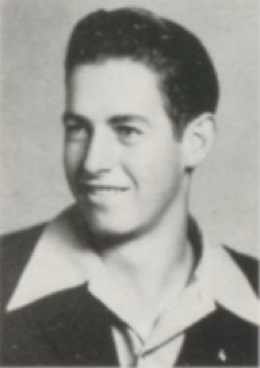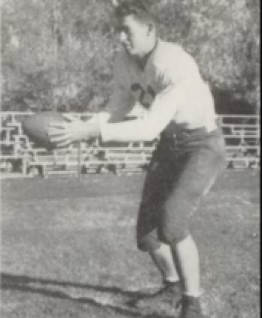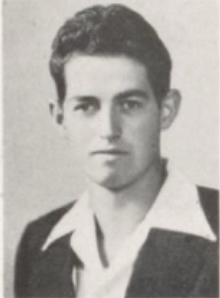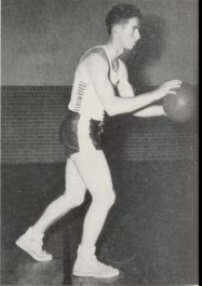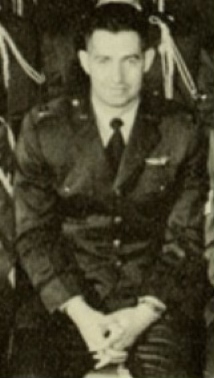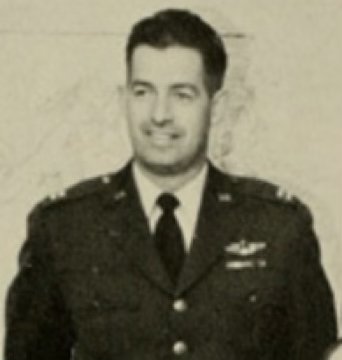JOSEPH E. BOWER, MAJ, USAF
Joseph Bower '52
Lucky Bag
From the 1952 Lucky Bag:
Joseph Edward Bower
Ely, Nevada
After reluctantly graduating from White Pine High School in Ely, Nevada, where he and his teammates chalked up a state championship in football his last year, Joe left his native "Indian Country" to embark on his service career as a buck private in the Army. While in the Army, Joe attended UMT at Fort Knox, Kentucky, from which he acquired the nickname "Umtee" at Navy. After football, Joe's favorite sport was deer-hunting. "Nothing like tramping those ole Nevada hills!" But generally you could find Joe either gazing at the pictures of his OAO, which completely covered his locker door, or wrestling with that Skinny book, his pet peeve.
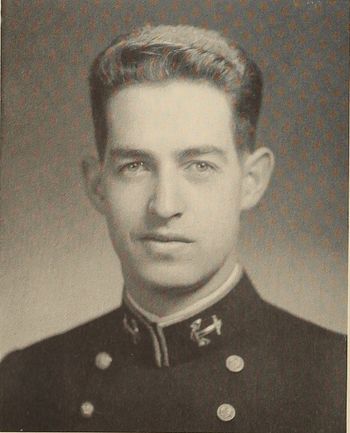
Joseph Edward Bower
Ely, Nevada
After reluctantly graduating from White Pine High School in Ely, Nevada, where he and his teammates chalked up a state championship in football his last year, Joe left his native "Indian Country" to embark on his service career as a buck private in the Army. While in the Army, Joe attended UMT at Fort Knox, Kentucky, from which he acquired the nickname "Umtee" at Navy. After football, Joe's favorite sport was deer-hunting. "Nothing like tramping those ole Nevada hills!" But generally you could find Joe either gazing at the pictures of his OAO, which completely covered his locker door, or wrestling with that Skinny book, his pet peeve.
Loss
Joseph was killed in action on August 3, 1965 when his F-105D jet fighter was destroyed by North Vietnamese anti-aircraft fire.
Other Information
From Wall of Faces; edited for clarity.
MAJ Joseph E. Bower was an F-105D pilot assigned an operational mission over North Vietnam on August 3, 1965. During the mission, Bower's aircraft was struck by hostile fire and Bower radioed that he was heading for sea (to facilitate easier rescue). Shortly afterward, the aircraft became uncontrollable.
I led my element out to sea to rendezvous with him. I was able to get within a thousand feet of him off his left wing. When I observed that his A/C was on fire, I radioed Joe that his aircraft was on fire and to bailout (like, “JOE! YOU’RE ON FIRE… BAIL OUT NOW!!!). Up until the telltale 50-foot long orange flame appeared coming from the tailpipe, a flame usually indicative of failed turbine blades (buckets), the aircraft flew normally.
He immediately responded to my instructions for ejection. I observed that before he separated from his chair, which occurs shortly after ejection, his aircraft exploded into several burning pieces. His chute opened immediately after chair separation. After full deployment of the canopy, I observed that a shroud line crossed over the canopy, which produced two canopies. This condition could have been corrected if Joe was conscious by cutting the errant line(s). I reduced my airspeed to 220 knots and lowered my flaps. I circled him until he hit the water. I noted a pronounced “shockwave” of water as he entered the sea, which appeared to me that he had fallen much faster than normal. His chute settled on him and all evidence of his chute disappeared rapidly.
He was at that time about 20 miles southeast of the city of Vinh in Ha Tinh Province, North Vietnam, very near the coastline. While I circled Joe, Holmes covered me for MIGs and O’Neil climbed to a satisfactory altitude to coordinate air-sea rescue. It appeared that he did not survive. There was no evidence of his raft; no radio communications; and all of this combined with a "bad" chute and high-speed entry into the water. There were a few boats in the area, but none of them were close to his location. We made several passes at the boats to warn them not to sail into Joe’s downed position by firing our 20mm canons across their bows before we had to leave due to low fuel. How effective that was we’ll never know. We also will never know what caused his aircraft to fail, his chute to fail, and whether he was conscious (or alive) after ejection.
Both Joe and I were assigned to the 421st in late 1963 until I joined the 354th. I deployed with the 469th in late 1964 to Japan, thence Okinawa, thence a short tour at Korat. I returned later to Korat with the 357th in mid-1965 where Bower and O’Neil were assigned to run the command post. Both Bower and O’Neil were attached to the 357th to fly combat missions. Will Koenitzer
From researcher Kathy Franz:
In high school, Joseph played tackle on the football team and center on the basketball team. He was a member of the Merit Society and the National Athletic Society.
Joseph enlisted in the Army on June 30, 1947, and went to Universal Military Training, Fort Knox, Kentucky. This was an experimental six-month course ordered by the federal government. The first group graduated in June 1947; the second in December 1947.
In the Army, he was secretary to the commanding officer at Bainbridge, Maryland. He attended training school at Fort Mead, Maryland, and then entered the Naval Academy on a congressional appointment by Rep. Charles H. Russell.
His cousin Edwin L. McCutcheon also graduated with Joseph from the Naval Academy in 1952. Joseph then went to Malden Air Base, Missouri, for primary pilot training.
In June 1952, he married Patricia Ann Baysinger of Indianapolis, Indiana. Their daughter Jillaine was born in 1954. In 1965 they lived in Wichita, Kansas.
In August 1953, Joseph graduated from basic jet pilot school at Bryan Air Force Base in Texas.
He attended Colorado State University and earned a master's degree in psychology. He was a member of Phi Delta Kappa. He taught four years at CSU on Air Force ROTC duty (1959-1963).
In May 1964, he was awarded his parachutist's badge at the U. S. Army's Airborne School at Fort Benning, Georgia. He was an F-105 Thunderchief pilot assigned to a Tactical Air Command unit at George AFB, California.
Beginning in July 1964, he was assigned to the 421st Tactical Fighter Squadron of the 355th Tactical Fighter Wing at McConnell Air Force Base.
From the Nevada State Journal, August 22, 1965: “Major Joseph E. Bower, Nevada's second victim of the Viet Nam War, was a man who accepted nothing short of excellence as his personal standard,” Gov. Grant Sawyer said yesterday.
In a funeral message read by Mayor Bruce Thiessen, Sawyer described Bower as a skillful flier, respected leader, distinguished scholar and teacher, and devoted family man.
Joseph's father Francis Elmer Bower was a truck driver, and his mother was Izora Ruth Helen (Lage.) Joseph's sister was Bonnie, and his brothers were Jack who died young and Richard David Bower. In 1930 Joseph's uncle and aunt, Walter and Aletha Lage, lived with them. Walter was a printer on the daily newspaper.
Joseph has a memory marker in Nevada; he is also remembered at the Courts of the Missing in Hawaii.
Photographs
Remembrances
From The Wall:
Major Joseph Edward Bower was a true hero as were all of the pilots flying during Vietnam. To set the record straight he was a Major not a Colonel on 3, August, 1965. He is my uncle and I will always remember him. I would like to say thank you to the other pilots flying with him that day. Pilots Koenitzer, Holmes, and O'Neil. I know you did everything possible to try and ensure his safety. My only hope is that one day he will no longer be listed as MIA. Joseph Rutledge, nephew, joerutledge2@hotmail.com, May 18, 2015
From Wall of Faces:
Joseph's only child and daughter Jill and her two sons Brian and Chris thank you for all the kinds words you have spoken in honor of Joseph E Bower. If you would like to contact Joseph's immediate family, here is an email at which you can reach us to send any messages or words of encouragement. pastor7b@gmail.com PASTOR7B@GMAIL.COM, 7/1/16
It been over 45 years but I still remember you and will always. As everyone can notice I am his named after him. I would like to hear from anyone who served with him. Thank you to all who do not forget the our MIA's JOE RUTLEDGE, JOERUTLEDGE2@HOTMAIL.COM, 10/7/12

The "category" links below lead to lists of related Honorees; use them to explore further the service and sacrifice of alumni in Memorial Hall.


